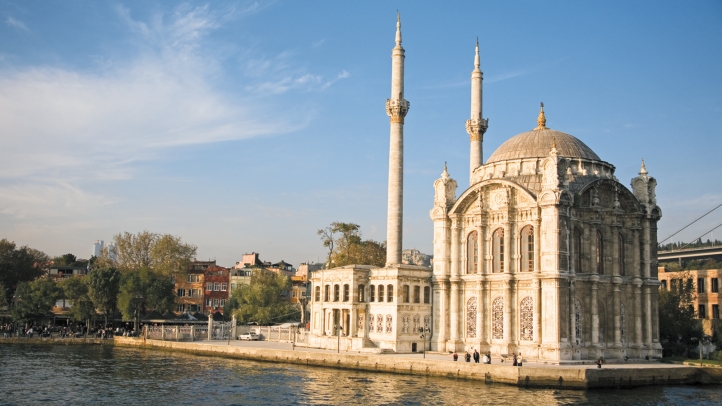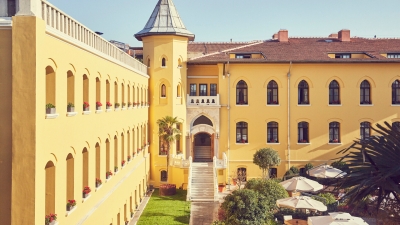Discover the Villages of the Bosphorus by a Private Boat with a Custom-Made Itinerary






Waterways usually offer attractive travel options, but very few can mesmerise its voyagers as the Bosphorus does. This 32 kilometre (20 mile) blue strait is the heart and soul of the city. Tiny fishing villages of a gone-by era are now the most valuable neighbourhoods of Istanbul and life is always very lively on both sides of the sea, although the Anatolian side is more residential than the European shore.
Splendid old wooden mansions on the waterfront - yalı in Turkish - unfortunately decreased in number over the years due to fires or neglect. Yet, the ones still standing are breathtakingly beautiful. A boat trip along the Bosphorus not only offers unforgettable scenes of the shoreline but also marvelous tastes to remember long after the trip is over. There are also unique spots on the way for high quality souvenir shopping.
Should you wish to stroll through the streets of old Bosphorus villages from Ortaköy to Emirgan and Beykoz to Beylerbeyi, experience the best samples of our traditional food and have an unforgettable feast for the eyes in the meantime, our Concierge at Four Seasons Hotel Istanbul at the Bosphorus will arrange custom made itineraries, with or without a guide.
After taking off from Four Seasons, a historical monument on the shores of Ortaköy, the first village of the Bosphorus, is the Grand Imperial Mosque of Ortaköy. This Neo-baroque style structure was commissioned by the Ottoman Sultan Abdülmecid and built between 1854 and 1856, on the ruins of the Cantemir Palace. Its architects were members of the famous Armenian family the Balyans, who also designed the Dolmabahçe Palace and the Imperial Mosque affiliated with it.
A little further away, you’ll notice one of the smallest mosques of Istanbul. Treasurer Ibrahim Pasha Mosque was built in the 17th-century and is a charming example of the tiny, wooden and well-proportioned Bosphorus mosques of the past.
Kuruçeşme Park is where the residential neighbourhoods begin. Although new hotels and restaurants pop up every day, this is still one of the laid back areas of the European seaside.
After Kuruçeşme, you’ll be reaching Arnavutköy. It is a small yet highly popular neighbourhood and deserves a special trip. Its narrow streets, adorned with beautiful old mansions and a beautiful 19th-century Greek church, offer a glimpse of a bygone era. There are also many attractive fish restaurants, cafes, ice cream parlours and pastry shops and you can easily spend half a day enjoying a few of them.
Without doubt, the trendiest neighbourhood of the whole strait is Bebek. Overlooking the beautiful Bebek Bay, houses on the slopes of this village are among the most expensive properties in the city. Although it gets over-crowded and noisy during the weekends, this is the place where everybody wants to be at!
The Egyptian Consulate is the main monumental building in Bebek. It offers a perfect example of the mixed, eclectic 19th-century Ottoman architectural style, which includes beautiful Art Nouveau details on a classical mould. Called Hıdiva Palace at the time, it was the summer palace of the Egyptian Khedive Abbas’s mother (the honorific rulers of Egypt under British rule). She spent her summers in this glorious mansion up until her death in 1931.
Bebek is also the first village you’ll hop off and there are numerous addresses worthy of a visit. Take a left as you get off the boat and you’ll be reaching Assouline Bookstore just across the street. Assouline publishes some of the best coffee table books around the globe, and you’ll find a very picky collection of home decoration objects, which will also make great gifts.
If you head towards the right, cross the street for Bebek Badem Ezmecisi. This traditional confectionary store is famous for its almond paste. Since 1904 they produce one of the very special tastes this city offers. Their pistachio paste is superb too, and since both are produced with age-old techniques, they contain no additives other than the pure taste of the very best almonds or pistachios.
Stay on the same side of the street, and a few metres away you’ll be reaching Envai. The word means "all kinds of" in Turkish and rightly so, as it offers a wide range of design objects, Turkish hand crafts, jewellery, traditional clothes, books, vintage boxes and more. Every corner, every shelf is filled with beautiful, charming objects and it is very likely that you’ll plan a second, longer visit. Bebek, Cevdet Paşa Cd. No:57 D:B, 34342 Beşiktaş/İstanbul
On the other side of the street there are three coffee shops, all with different styles. The first one is Starbucks, which you’ll naturally spare a visit, but think twice before you do. This one has probably the best view of all Starbucks branches around the globe. Save your appetite for other places but have a quick look at inside and see how lucky regular Bebek Starbucks customers are.
For a unique Turkish coffee experience, Selamlique is the best stop not only in this neighbourhood but perhaps all over the town. The “Selamlık" of old Turkish mansions and palaces were sections of the house where visitors were greeted and entertained. Selamlique thus aims to draw attention to the socialising power of Turkish coffee. They serve delicious Turkish delights too but make sure you taste their delicacies first. These tiny flavoured chocolates filled with crunchy almond, taste like nothing else. If you choose mastic and rose flavours on the side of a cup of Turkish coffee, it is very likely that your senses will carry you away to the dream-like Selamlık of an old Ottoman mansion.
The third coffee shop on this row is Baylan. You’ll get an amazing view of the bay and the Egyptian Consulate building from its balconies. If you decide to take a seat, make sure you try their cup griye. Baylan is a century-old institution and this dessert with ice cream, caramel and crunchy almonds makes every sweet tooth feel like he/she was on cloud nine. If it’s not going to be your meal of the day, sharing this huge portion will be a wiser choice.
After visiting Bebek you’ll hop on the boat again and pass by Aşiyan before the Rumeli Fortress takes your breath away. This monumental fort was built at the narrowest section of the Bosphorus strait, directly opposite to Anadolu Hisarı (the Anatolian Fortress) in 1452, by the Ottoman Sultan Mehmet II. Its purpose was to prepare the downfall of the Byzantine Empire by cutting off sea routes, and one can say that it served its purpose well as the city fell to the Turks less than a year later.
Just before reaching the Fatih Sultan Mehmet bridge you’ll see a tall, red brick house with a lengthy tower. This idiosyncratic building is the Borusan Contemporary. It serves as Borusan Holding offices during the weekdays yet it opens its doors every weekend for art lovers who want to enjoy their collections and exhibitions.
Before arriving to the Emirgan pier, you’ll see the Baltalimanı Hospital, which was built in the 19th-century and was used as a hunting lodge by the Ottoman elite.
Emirgan is where you’ll hop off for the second time. The neighbourhood is one of the oldest settlements of the Bosphorus and is known today for its beautiful park and the prestigious Sakıp Sabancı Museum. The villa, which is now the museum's main building, was first used by the members of the Egyptian Hidiv family and later by the current owners, the Sabancı family. In 1998, this wealthy family of industrialists decided to turn it into a museum so as to display the family’s large calligraphy and painting collection. A modern gallery was added to the existing villa and the museum opened its doors in 2002. Even if you’re not planning a visit to the museum itself, a walk in the garden will be pleasurable. You can also have a seat for a drink at the MSA Restaurant within the museum and enjoy the peerless view of the Bosphorus from between the century-old pine trees.
Next to the SSM, you’ll see a cafe filled with a loud crowd, savouring their tea and treats. Sütiş is a very old Turkish institution and serves both as a dessert shop and a restaurant. Even if you don’t feel like spending your time there just go inside and enjoy the scene of the vast dessert variety.
Before hoping on the boat again, make sure your eyes didn’t miss the remarkable Ottoman fountain under the huge plane tree, a centrepiece of the neighbourhood.
After you pass by Istinye bay, a beautiful array of splendid old yalis will carry you back to the glamorous lives of the 19th-century Ottoman high-bourgeoisie. Yeniköy, with its multimillion-dollar waterfront villas, has been an important settlement for ages. The plentiful strawberry fields or wealthy Ottoman Greek bankers are nowhere to be seen, but Yeniköy keeps attracting the common and the rich folk, safeguarding its privileged status to the present day.
After contemplating the beautiful seaside mansions, the boat will cross the Bosphorus, carrying you from one continent to the other.
When you reach the shores of Beykoz, another age-old Bosphorus village, the boat will turn around and cruise around the Asian shore of the city. Beykoz was famous for its hunting lodges during the Ottoman era and in 19th-century a great leather factory was built for mass shoe production. Today, this building and its environment act as the number one studio of famous Turkish TV series.
When you reach Çubuklu, turn your eyes uphill to observe the tower of the beautiful Khedive’s Palace. This huge mansion and its gardens was sold to the municipality of Istanbul in 1931 and serves as a park and restaurant since then.
Your first stop on the Anatolian side will be at Kanlica, a neighbourhood visited by many people for its tasty yogurt. Ismailağa Cafe is a good option for experiencing this traditional dairy, which is made daily, without any additives. In contrast with Western practices, Turkish cuisine uses yogurt in savoury dishes, but Kanlıca yogurt is always served with a topping of confectioner’s sugar, and this is where our yogurt consuming traditions get closer to the Western taste palate. Kanlıca, Barış Manço Cd. No:4, 34810 Beykoz
After this short break you’ll hop on again and continue towards the Anadolu Hisarı. This neighbourhood gets its name from the Anatolian Fortress that was built half a century before the Rumeli Fortress. The two fortresses worked in tandem during the final siege of Constantinople to throttle all naval traffic along the Bosphorus.
Passing by the fortress, a small but flamboyant building, the Küçüksu Pavilion will remind you of some of the monumental buildings you’ve encountered all along the way. Designed by the famous Balyan family, this old hunter’s lodge shares similar details with many of the architects’ works and their favourite style.
The Anatolian shores are adorned with the most elegant wooden mansions of the Bosphorus shoreline. Used as the summer residences of Ottoman high-bureaucrats and officers, some of them have been restored and are still owned by the wealthiest members of Turkish society, while some others are hardly standing. Yet, they still carry the charm of a past era and long-lost lifestyle.
Your second stop on this coast will be Kandilli. Right where you get off the boat, you’ll observe a cheerful crowd enjoying their food, no matter what time of day it is. Kandilli Balıkçısı Suna Abla is a famous fish restaurant and empty seats are almost impossible to catch as of noontime. If you intend to give a late lunch break here, make sure to reserve your place beforehand. Kandilli İskele Cd. No:4, 34684 Üsküdarl Tel: (0216) 308 45 12
When in Kandilli, a short walk up the main road is always an attractive option. This is another old and well established Bosphorus village and you’ll see many picturesque mansions even before reaching the top of the hill. The chic Kandilli Patisserie is ideal for a Parisian style coffee break. If you are not too full with Suna’s delicious food their croissants and tarts are perfect to accompany your coffee.
When you’re back on the boat, the first structure that will get your attention will be Kuleli. Built during Sultan Abdulmecid era by the Balyan family as a military building, it was transformed into a military hospital during the Crimean War (1853-1856). After the foundation of the Republic, it served as a military school till 2016. It is now under renovation and will open its doors as a military museum soon.
One of the glorious, must-see monuments of Istanbul is the Beylerbeyi Palace. After the fire in 1829 its final restoration was made by the Balyans and the all-powerful Sultan Abdülhamid II spent his summers there. Because it was built as a summer mansion the palace didn’t have a heating system. The Shah of Iran and the Duke and Duchess of Windsor are among the famous guests who enjoyed its very special location and peerless beauty.
Should you wish, your boat may cross the Bosphorus for the second time and take you to the shores of Dolmabahçe Palace. The glamorous, even ornate structure of the modernisation era of Ottoman Empire took 13 years to build (1843-1856) Six different architects worked on it, two of them being from the Balyan family. Once the dwelling place of the Sultans, Mustafa Kemal Atatürk used it as his main residence after the foundation of the Republic, till his death in 1938. Today the Dolmabahçe Palace is open to visits with its many galleries, museums and beautiful gardens.
After passing by the Dolmabahçe Palace, there remains only the ever-busy Beşiktaş coast between you and the tranquil seaside garden of Four Seasons Hotel Istanbul at the Bosphorus.

Istanbul, 34349
Türkiye

Istanbul, 34349
Türkiye



 @FourSeasonsPR
@FourSeasonsPR